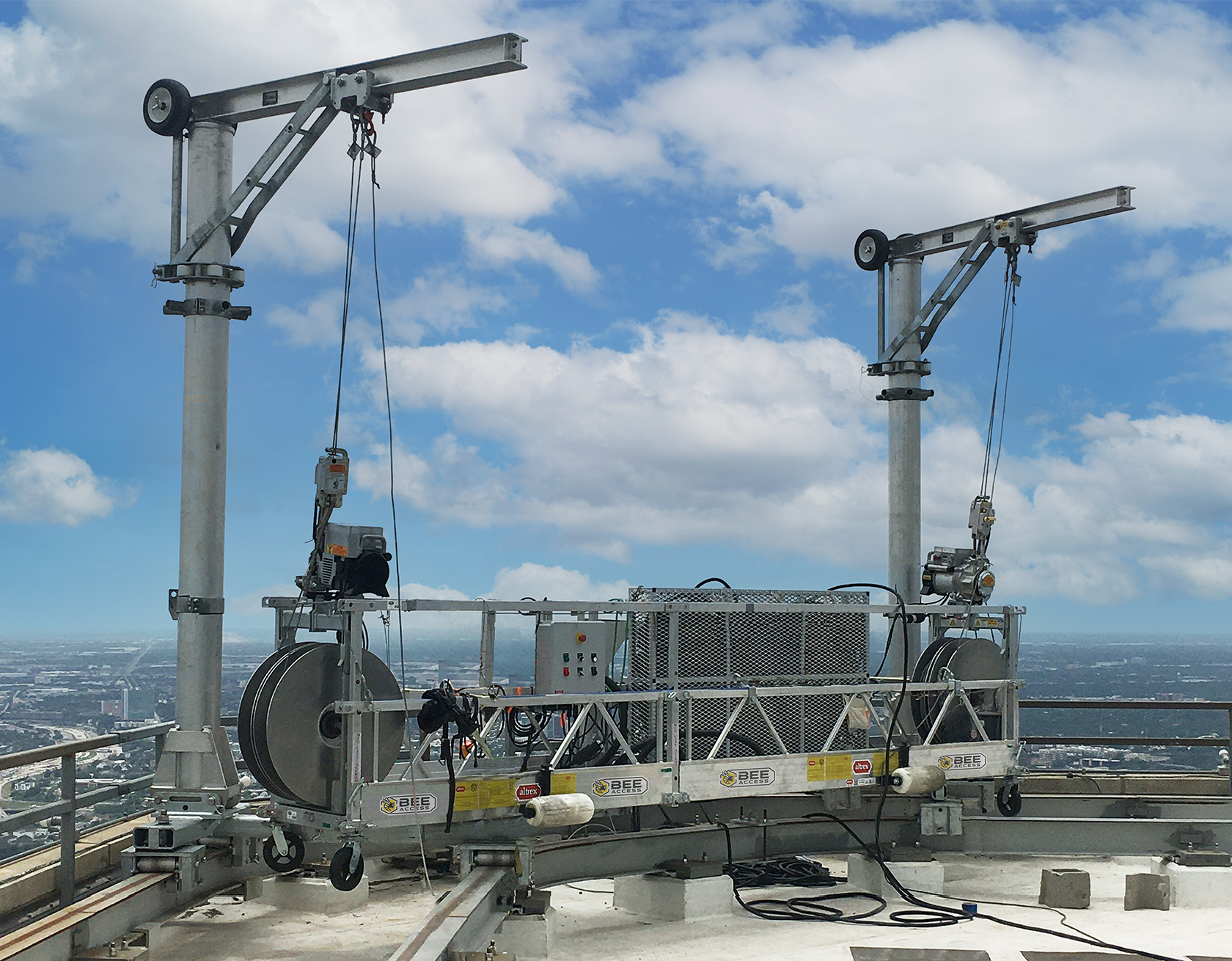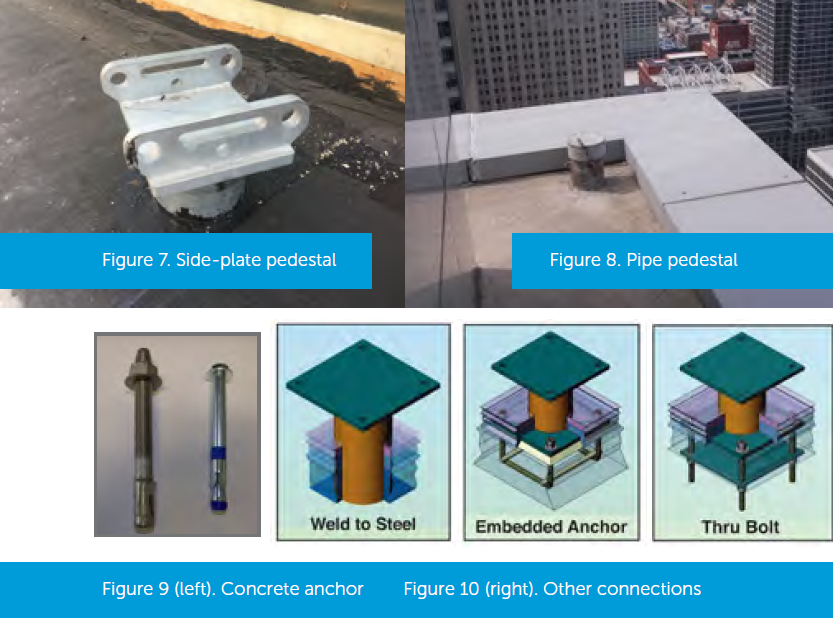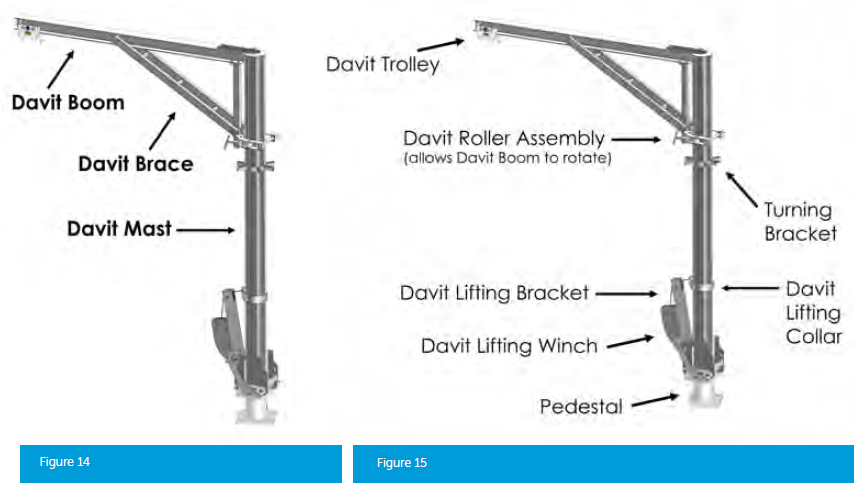
This article submitted by the Permanent Installation Council provides information about Davits and related suspended access equipment.
Over the years, numerous types of suspended access equipment, such as anchors, pedestals, sockets, and outrigger beams, etc., have been referred to as davits. They are not davits, however, and this article will clarify what makes a davit, a davit. (see Figures 1-3).

A davit is a crane-like device used for supporting, raising, and lowering temporarily or permanently suspended access equipment or material. To become more familiar with the terminology, portable davits can be broken down into two categories, ground-rigged and roof-rigged. A ground-rigged davit is used when the suspended platform is launched from the ground and does not go above the building face or parapet. A roof-rigged davit is used when the platform is launched from the roof, goes above the parapet, and rotates out to descend along the outside face of the building. Ground and roof-rigged davits have two types of subcategories, bottom or top-rotating. This is easily identified by where they rotate. (See Figure 4.)
Unlike outrigger beam setups, a davit has a single attachment point into the structure which supports its operating moment load. This attachment point is called the pedestal. The pedestal is a component which is attached to the building/structure and supports the davit loads.
There are several different types of pedestals, including flush, flat plate, channel, side plate, and pipe:


Pedestals may be connected to the building structure numerous ways (Figures 9 and 10):
When used, a socket, which also supports the davit, is either permanent (fixed) or portable and is a receiver for the bottom-rotating davit mast. (See Figures 11-13.) A socket usually allows a davit to be tilted into position by being raised or lowered via a winch assembly. The socket must be secured to the pedestal before use. Depending on the pedestal type and manufacturer, there are numerous ways of securing a socket to the pedestal. Some manufacturers design the socket to pin directly to the pedestal, while others use an adapter to secure the socket to the pedestal. Other manufacturers combine the adapter with the socket into one assembly that secures to the pedestal.

Davits can be broken into three components, mast, boom, and brace (Figure 14). Davit masts are the vertical component of a davit and are usually made from round pipe, a special extrusion, or square or rectangular tubing. Depending on the application, the davit mast may have any of the following items: turning bracket; davit lifting collar; davit lifting winch; davit lifting bracket; or davit transport wheel (Figure 15).
Davit booms are the horizontal component of a davit. Booms are generally made from the same material as the mast or from other extruded shapes, such as I-beams, channels, or special profiles. Some of these profiles allow a suspension trolley (Figure 15) or suspension collar/plate to move along the length of the boom.
Davit braces connect the mast to the boom and support the davit boom. Each brace is usually made from channel, plates, or square/rectangular tubing. For top rotating davits, the brace connects to a roller assembly (Figure 15) that allows the boom to rotate. For bottom rotating davits, the brace connects directly to the davit mast.

In summary, davit assemblies are made up of two or three items; pedestal, socket or adapter, depending on manufacturer, and the ground or roof-rigged davit. Davits are a wonderful asset to any building where they can be used with temporary or permanently suspended access equipment. When properly maintained and inspected, the pedestal and davit will provide safe and dependable access to the building facade.
Please note that even though this article covers a lot about davits, it is not all encompassing, and each building has different requirements. Therefore, please contact a suspended access equipment provider or a davit manufacturer for more information – and be sure to call davits, davits!
About the Authors
Brian Andrews is the VP Engineering at Bee Access and Chair of the Scaffold & Access Industry Association (SAIA) Permanent Installation Council. Contact him at brian@beeaccess.com